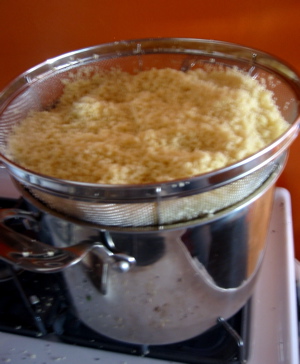The traditional way to make couscous

You may remember that I blogged about my Moroccan cooking class a few months ago. Last night, we had family over for dinner and I dilligently recreated all the recipes I learnt in my class. Some of you were interested in how to make couscous the traditional way so here's Chef Myra Kornfeld's recipe which I used. It was definitely laborious to say the least, but well worth the effort.
The process of wetting, drying, raking, aerarting, and steaming the semolina grains is done with the purpose of swelling them with as much water as possible without allowing them to become lumpy or soggy. You need either a couscousiere or a pot with a colander on top (like the one in the photo). A pasta cooking pot that comes with a steamer insert makes a good substitute couscousiere.
1. First washing and drying of the couscous: Wash the couscous in a large shallow pan by pouring water over the grain in a ratio of 3 parts water to 1 part grain. Stir quickly with the hand and then drain off excess water through a strainer. Return the coucous grains to the pan, smooth them out, and leave them to swell for between 10 and 20 minutes. After about 10 minutes begin, with cupped, wet hands, to work the grains by lifting up handful of grain, rubbing them gently and letting them fall back into the pan. This process should break up any lumps that may have formed. Then rake the couscous with your fingers to circulate it and help the grains to swell.
2. First steaming of the couscous: Dampen a strip of cheesecloth, dust it with flour, and twist into a strip the length of the circumference of the rim of the bottom part of the coucousiere. Use this to seal the perforated top or colander on the top of the pot. Check all sides for effective sealing: the top and the bottom should fit snugly, so that the steam rises only through the holes. The perforated top should not touch the broth below. Slowly dribble one-quarter of the swollen couscous grains into the steamer, allowing them to form a soft mound. Steam 5 minutes and gently add the remaining couscous. When all the grains are in the steamer, lower the heat to moderate and steam 20 minutes. Do not cover the couscous while it steams.
3. Second drying of the couscous: Remove the top part of the couscousiere (or the colander). Dump the couscous into a large, shallow pan and spread out with a wooden spoon. Sprinkle 1/2 to 1 cup cold water and 1 teaspoon salt all over the grains. Separate and break up lumps by lifting and stirring the grains gently. Oil your hand lightly and rework the grains - this helps to keep each grain separate. Smooth the couscous out and allow it to dry for at least 10 minutes. If the couscous feels too dry, then add another cup of water by handful sprinnkles, and rake the couscous well before each addition. If you are preparing couscous in advance, at this point let it dry and cover it with a damp cloth. It can wait many hours.
4. If you want to serve right away, allow the couscous to dry for 10 minutes, then pile it back into the couscousiere top, being sure to reseal the two containers with a cheesecloth, for its final steaming of 20 minutes. If you have prepared steps 1-3 in advance, 30 minutes before serving break up lumps of couscous by working the grains lightly between your wet fingers. Steam the couscous in the couscousiere top for 20 minutes, as previously directed.
Do let me know how the couscous turns out if you follow these steps.


9 Comments:
will, try this, though i don't have a couscousiere. but i can use a colander right?
hi rums,
absolutely! i don't have a couscousiere either. i used a large pot and a colander. i didnt even have to use a cheesecloth as my colander fit snugly over the pot. happy couscousing!
Wow! That's a lot of work, but I am dying to try it and see how it compares to the old, boil and dump method.
Question--do you use regular couscous or is there a non-instant version?
hi amy
either is fine as long as you use the above method. let me know how it works out.
lulu
which all groceries can you buy couscous from in Bangalore?
This is very helpful, Can you tell me the broth inside the couscousiere, what is it made of?
Can you use American red or white hard wheat?
Thanks for these clear instructions. I have a couscousiere and have up to now had poor results, but I suspect this will do a lot better. I usually line the top part with muslin. Makes handling the couscous easier.
Post a Comment
<< Home